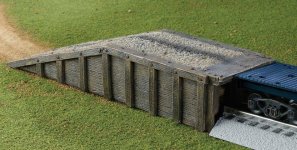alskdjfhg
Diamond
- Joined
- Feb 20, 2013
- Location
- Houston TX
For those that don't know, I have a 15,500 lb lathe that is occupying a trailer that I need to get unloaded.
I was planning to unload it by making two gantry cranes and using chain hoists.
I went to the scrap yard that is about a mile from the farm and they have about 20 W14x43 beams (I just measured them with a ruler so they could be up to W14x53, but let's just say they are the lighter ones). I went to McMaster and looked up what size beam they use for a 10,000lb capacity gantry crane, they says it's a 5x12 beam. So I assume with these beams being larger they they would be up the task (I want them to be able to handle a minimum of 10k, but I would like more).
But when I used this calculator; WebStructural, it says that the beams will fail*. So I would like someone to check this, preferably tell me how I would go about calculating the strength of beams, but all I need right now is for someone to tell me what a W14x43 beam with a 9ft span will do under a 10k load.
Thanks for any and all help.
*They fail when I specify that beam is going to be unbraced.
I was planning to unload it by making two gantry cranes and using chain hoists.
I went to the scrap yard that is about a mile from the farm and they have about 20 W14x43 beams (I just measured them with a ruler so they could be up to W14x53, but let's just say they are the lighter ones). I went to McMaster and looked up what size beam they use for a 10,000lb capacity gantry crane, they says it's a 5x12 beam. So I assume with these beams being larger they they would be up the task (I want them to be able to handle a minimum of 10k, but I would like more).
But when I used this calculator; WebStructural, it says that the beams will fail*. So I would like someone to check this, preferably tell me how I would go about calculating the strength of beams, but all I need right now is for someone to tell me what a W14x43 beam with a 9ft span will do under a 10k load.
Thanks for any and all help.
*They fail when I specify that beam is going to be unbraced.





